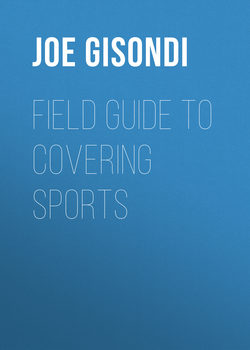Читать книгу Field Guide to Covering Sports - Joe Gisondi - Страница 17
На сайте Литреса книга снята с продажи.
Where Do You Start?
ОглавлениеGlenn Stout was minding his own business, just a fan reading about sports during his gig at the Boston Public Library, when he fell into journalism.
Stout, now editor of The Best American Sports Writing series, had stumbled across an old article about a Red Sox manager who committed suicide in 1908. The article cited the pressures of managing as the reason for the suicide.
“If that were the case,” Stout says, “I thought there should be a whole cemetery of dead Red Sox managers.”
To satisfy his own curiosity, Stout, a 27-year-old librarian, investigated what really happened by reading old newspaper clips on microfilm. He then reviewed an old book on freelance writing to develop a query letter, which he sent to The Boston Globe and Boston Magazine. The Globe rejected his story idea, but the magazine’s editor invited him in.
Stout did not have a single clip, had never tried to write a magazine piece, and had majored in creative writing, not journalism. Yet the editor took a chance, buying the story on the Red Sox manager’s suicide for $300 on spec.
“I still had the idea in my head that I wanted to be a writer, but really had no plan on how to become one, but knew I could write,” Stout says. “I’d been reading sports stuff for fun forever. So I worked my ass off for a week at a time when you had to write longhand and then go to the typewriter, and turned in the story. He bought it as is, and asked me what I wanted to write about next. I blurted something out, and he gave me a contract for another story for $500. I was their sports columnist for the next three years and have never been without a writing assignment since. I’ve sold virtually everything I’ve tried to.”
L. Jon Wertheim, now a veteran writer for Sports Illustrated, wrote a profile on the New Jersey Nets’ Chris Dudley for Hoop magazine, an assignment that was a thrill for him when he was a college senior at Yale, partly because he could escape a few nights of scraping uneaten food off plates.
“The pay was something like $250, which doesn’t sound like much now,” Wertheim says, “but it was about 40 hours worth of wages working at the dining hall, so I figured I had pulled a fast one.” Today Wertheim is an executive editor and senior writer for Sports Illustrated and si.com.
Countless reporters enter the profession at high school basketball courts and football fields in small towns, at minor league ball fields, and in hockey rinks. There is no single path to success, although hard work, curiosity, and perseverance are excellent guides.
At the same time, there is no such thing as the typical sports story. Cookie-cutter approaches lead to stale, uninteresting stories. Instead, take chances and cultivate a voice, as you take readers through sports events.
“You’re looking at a game from a point of view,” says Bob Ryan, author and award-winning writer for The Boston Globe. “That’s the key phrase. Why would you send someone to cover a game if you’re going to force them into a very rigid box of formality? You could just take the wire story.”
Sports writers need to be confident, taking chances like a coach or player. “I think more writing is destroyed by an abundance of caution than by risk,” Stout says.
Sports Insider: On Criticism
I’ve been a full-time writer since 1993 and keep doing this because it beats working. But it is important for young writers to understand that you never arrive—each time you kick in a door there’s another one, and no one really cares what you did in your previous assignment. But it is not for everyone, because each minute you spend writing is a minute you spend alone inside your own head, and some people can’t handle that. And your work is out there forever, and sometimes the object of criticism, so it helps to have a thick skin as well.
Glenn Stout, editor, The Best American Sports Writing series
